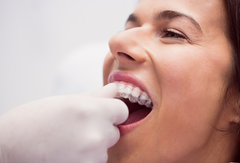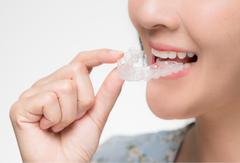Brushing & Flossing with Metal vs Ceramic Braces: Tips for Oral Hygiene
Maintaining optimal oral hygiene during orthodontic treatment is essential to prevent complications such as cavities, gum disease, and staining. Both metal and ceramic braces introduce additional surfaces where food particles and plaque can accumulate, necessitating diligent cleaning routines.
Metal braces are renowned for their durability and effectiveness in correcting complex dental issues. However, their design can make cleaning more challenging, requiring meticulous brushing and flossing techniques. The Cleveland Clinic emphasizes the importance of consistent oral care to protect teeth throughout treatment.
Ceramic braces, while offering a more discreet appearance, are more susceptible to staining if not properly maintained. Their lighter-colored brackets can discolor from certain foods and beverages, making thorough cleaning after meals crucial.
For individuals seeking a more convenient alternative, Smileie Clear Aligners provide a removable solution that simplifies oral hygiene routines. By allowing users to brush and floss without navigating around brackets and wires, aligners help maintain oral health more effectively during treatment.
Regardless of the orthodontic appliance chosen, adhering to proper brushing and flossing techniques is vital to ensure a healthy and confident smile throughout the orthodontic journey.
Understanding the Differences Between Metal and Ceramic Braces
Metal and ceramic braces both work effectively to correct misalignment, but they differ significantly in appearance, durability, and maintenance. Metal braces are the more traditional option and are made from strong stainless steel, which makes them reliable for complex orthodontic cases. However, they are more noticeable, which can be a concern for individuals who prefer a discreet solution. Ceramic braces, on the other hand, feature clear or tooth-colored brackets that blend in with the natural teeth. This makes them more appealing aesthetically, especially for adults and teens conscious of how they look during treatment.
While ceramic braces offer subtlety, they require more care to prevent staining and are slightly more fragile than metal braces. Some patients may also find them a bit more sensitive. The choice often comes down to lifestyle, treatment goals, and how much maintenance one is willing to commit to. For those seeking a comfortable and low-maintenance alternative, Smileie Clear Aligners provide a removable solution that makes daily hygiene and aesthetics far easier to manage.
Why Oral Hygiene Is So Important with Braces
Maintaining excellent oral hygiene during orthodontic treatment is essential to prevent complications such as cavities, gum disease, and staining. Braces introduce additional surfaces where food particles and plaque can accumulate, necessitating diligent cleaning routines. If these areas are not cleaned properly, the risk of developing cavities, gum inflammation, and even early signs of gum disease increases significantly.
Poor oral hygiene can also lead to white spot lesions, which are early indicators of enamel decalcification. These can become permanent marks once the braces are removed, diminishing the aesthetic results of treatment. In more severe cases, unchecked plaque buildup can cause swollen or bleeding gums, delaying orthodontic progress and leading to more serious dental issues.
As highlighted by Martindale Dental, consistent brushing and flossing around brackets and wires, along with routine dental visits, are vital for long-term oral health. The goal is not just straight teeth, but a clean, healthy smile once the braces come off.
For individuals seeking a more convenient alternative, Smileie Clear Aligners provide a removable solution that simplifies oral hygiene routines, allowing for easier cleaning and no dietary restrictions.
Brushing Techniques for Metal Braces
Brushing with metal braces requires extra care and consistency to maintain oral health during treatment. Brackets and wires can trap food particles and plaque in places a regular brush might miss, making it important to develop a thorough technique.
Start with a soft-bristled toothbrush or an orthodontic toothbrush designed to reach around braces. Hold the brush at a 45-degree angle and use small circular motions to clean above, below, and around each bracket. Make sure to brush the outer surfaces, inner surfaces, and chewing surfaces of every tooth.
Pay special attention to the gumline, where plaque can quickly build up and lead to inflammation if not removed properly. Using fluoride toothpaste helps strengthen enamel and reduce the risk of white spots forming around brackets. For areas that are harder to reach, an interdental brush is helpful for cleaning between wires and around brackets.
With consistent effort and the right tools, brushing with metal braces can be just as effective as brushing without them. A clean mouth ensures that when the braces come off, your smile will be healthy and free of stains or decay.
Brushing Tips for Ceramic Braces
Brushing with ceramic braces requires a balance of gentleness and precision to protect the appearance of the brackets and maintain good oral hygiene. While ceramic braces are less visible than metal ones, they are more prone to staining and need careful daily maintenance to avoid discoloration around the brackets.
Use a soft-bristled toothbrush and fluoride toothpaste, brushing at a 45-degree angle to reach above and below each bracket. Pay attention to the surfaces around the brackets, as well as the gumline and chewing surfaces of each tooth. Brushing after every meal helps prevent food particles from settling into small crevices and reduces the chance of staining.
Avoid heavily pigmented foods and beverages such as coffee, tea, and berries, as these can leave marks on the ceramic material. If consumed, rinse your mouth or brush soon afterward. An interdental brush can be useful for cleaning between the brackets and under the archwire.
Consistent brushing with proper technique will help keep your ceramic braces clear and your smile healthy throughout treatment.
Flossing Strategies That Actually Work
Flossing with braces can feel tricky, but it is essential for preventing plaque buildup, gum irritation, and cavities. Brackets and wires create tight spaces that easily trap food, which makes proper flossing techniques even more important. One effective tool is a floss threader, which helps guide dental floss under the archwire. Once in place, gently move the floss between the teeth and along the gumline, being careful not to snap it. This method, while a bit more time-consuming, provides thorough cleaning when done consistently.
For added convenience, many orthodontic patients prefer using a water flosser. It delivers a steady stream of water that dislodges debris from between teeth and around brackets without the need to thread traditional floss. Interdental brushes are also helpful for cleaning hard-to-reach areas and under wires. Using these tools together improves efficiency and reduces the risk of plaque buildup. When incorporated into your daily routine, these flossing strategies will keep your teeth and gums healthy and set the foundation for a cleaner, brighter smile after treatment.

Latest Blog
-
 Oct 17, 2025
Oct 17, 2025Cost Breakdown: Clear Aligners vs Veneers Which Is Worth Your Money in 2025?
Learn More -
 Oct 16, 2025
Oct 16, 2025Invisible Braces vs. Clear Aligners: Differences in Treatment Time and Comfort
Learn More -
 Oct 15, 2025
Oct 15, 2025Best Invisible Braces for Adults in 2025: Comfortable, Affordable, and Effective Choices
Learn More -


 USA
USA Canada
Canada UK
UK Italy
Italy Sweden
Sweden Australia
Australia




